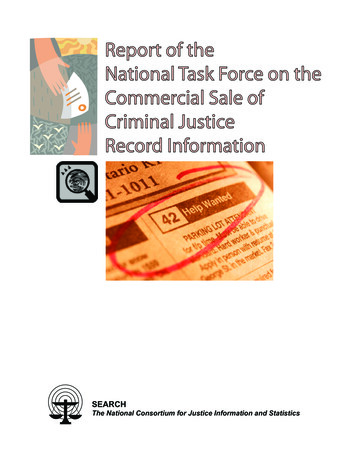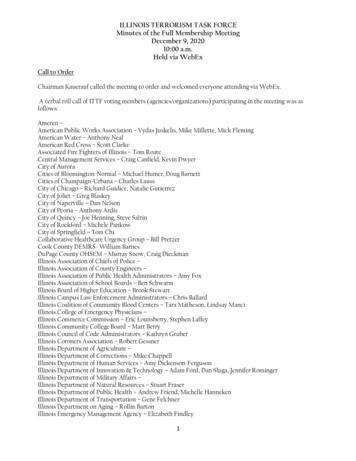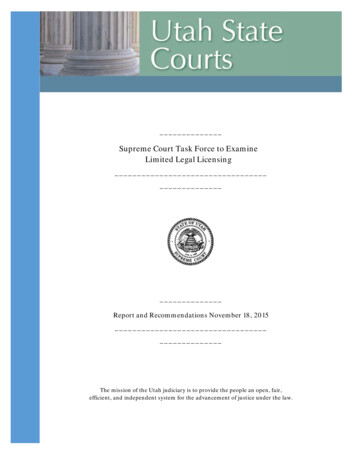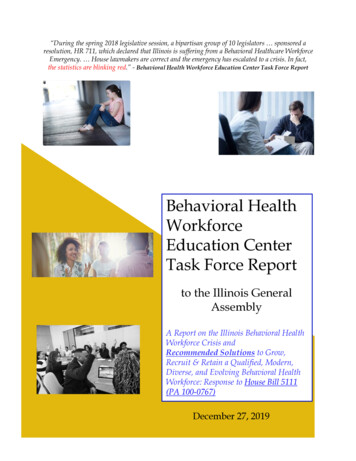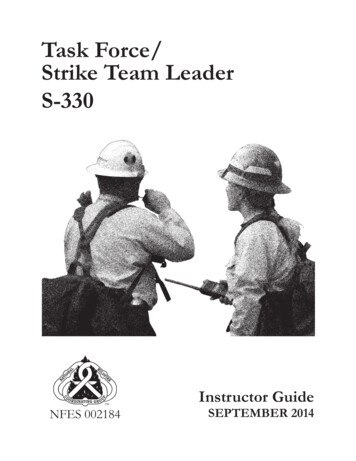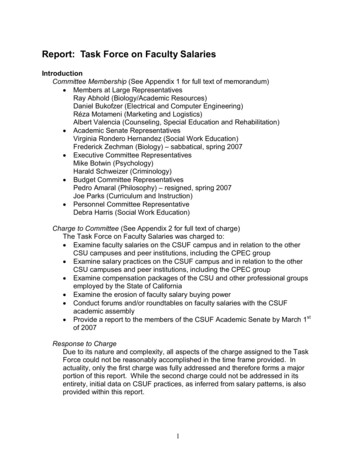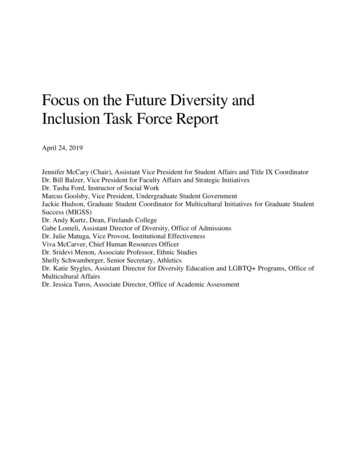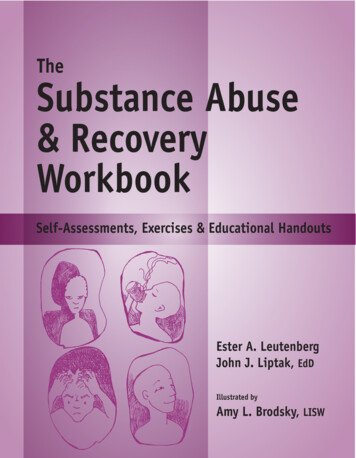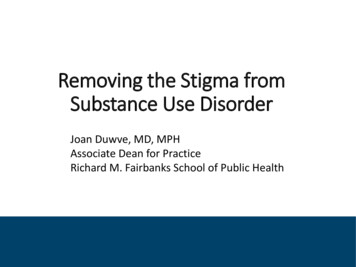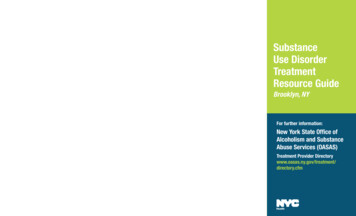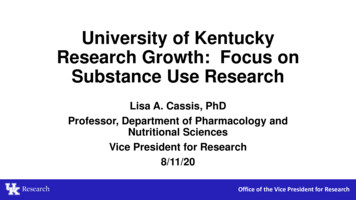
Transcription
University of KentuckyResearch Growth: Focus onSubstance Use ResearchLisa A. Cassis, PhDProfessor, Department of Pharmacology andNutritional SciencesVice President for Research8/11/20Office of the Vice President for Research
Outline Record-breaking growth in research atUK Declaration of Substance Use Researchas an institutional Research Priority Areaand the resultant impact on UK researchOffice of the Vice President for Research
Grants and Contracts to UKInvestigators are Growing RapidlyFY15 – FY20CAGR 9% 450 MFederal GovernmentState Government 429.1MOther Sources 400 M 74. M 69.9 M 350 M 300 M 250 M 200 M 71.2 M 62.3 M 58.3 M 73.7 M 81.8 M 90.7 M 61.2 M 87 M 101.3 M 72.7 M 150 M 100 M 153.1 M 163.5 M 178.3 MFY 2015FY 2016FY 2017 200 M 241.8 M 272.2 M 50 M MSource: UK OSPA Database, keyword searches (6/30/2020.FY 2018FY 2019FY 2020Office of the Vice President for Research
In 2018, we declared Substance Use DisorderResearch as a Research Priority Area at UK One of six Research Priority Areas*focused on innovation & discovery inareas of need throughout theCommonwealth Existing institutional strength andexperts with a long history of fundedresearch in this area The UK Presidentdeclaredresearch7373on racialinjustice and Projectshealth equityProjectsas the 7th institutional researchpriority (8/5/20)75Projects105Projects*Fine more information on the UK Research Priority Initiative here: nitiativeOffice of the Vice President for Research
What does it mean to be a ResearchPriority at UK? Established leadership, governance, membership definitions Grass roots definition of research objectives and associated metricsto track success Long-term sustainability of the research and clear definition of itsimpact (e.g., 40% reduction in deaths from opioid overdose) Coordinated growth across disciplines, colleges and academicboundaries Speak with a uniform voice on a problem or source of economicdevelopment that aligns with Kentucky’s most pressing needs andchallengesOffice of the Vice President for Research
What is the impact ofdeclaring Research PriorityAreas for UK?Office of the Vice President for Research
Since 2018, there has been extensive growth in grantsand contracts within Research Priority Areas 80 M 70 MFiscal Year 2015 through 2019 60 M 50 M 40 M 30 M 20 M 10 M MCancerCAGR 4.3%Diabetes &ObesityCAGR 5.7%Cardiovascular Substance AbuseCAGR 2.4%CAGR 25.5%NeuroscienceEnergyCAGR 18.4%CAGR -0.3 %Note: Awarded projects for each thematic area are not mutually exclusive. Projects may be represented in one or more areas. Additionally, projects are based on keyword searches and may not include allrelated projects and may contain some projects that aren’t specific to that area of research. Source: UK OSPA DatabaseOffice of the Vice President for Research
Substance Use Research has Experienced the LargestGrowth in Grants and Contracts 90,000,000 80,000,000 70,000,000FY15 – FY19CAGR 25.5% 75,216,902 60,000,000 50,000,000 40,000,000 30,000,000 20,000,000 10,000,000 30,275,88273Projects 27,902,51773Projects 29,980,715 019 020152016Source: UK OSPA Database, keyword searches (9/10/2019.Office of the Vice President for Research
Participation from Substance Use ResearchersAcross the Full Spectrum of UK’s Departmentsand Colleges Agriculture, Food, and the EnvironmentArts and SciencesBusiness and EconomicsCommunication and macyPublic HealthSocial WorkDepartments Include(but not limited to)Behavioral SciencesCenter on Drug and Alcohol ResearchChemical and Materials ologyFamily and Community MedicineHealth BehaviorNeuroscienceNursingPharmaceutical Techand many moreOffice of the Vice President for Research
University of Kentucky:Substance Use Research & Treatment ActivitiesSubstance Use Recovery Task ForceMeeting 2: August 11, 2020Sharon L. Walsh, Ph.D.Center on Drug and Alcohol ResearchSubstance Use Research Priority Area
Outline HEALing (Helping to End Addiction Long-term) CommunitiesStudy* Other Key Studies funded by the National Institutes of Health Kentucky Opioid Response (KORE) funded partnerships withUK* Building SUD Workforce Capacity in the Appalachia Region*
THE HEALING COMMUNITIES STUDYIn September 2018, NIH released a funding opportunity to “test the immediate impact ofimplementing an integrated set of evidence-based interventions across healthcare, behavioralhealth, justice, and other community-based settings to prevent and treat opioid misuse andOpioid Use Disorders (OUD) within highly affected communities” 87 million was awarded to the University of Kentucky (one of four states to receive theaward). Massachusetts, New York, and Ohio were also awarded (April 2019)Our project is being conducted in partnership withnumerous federal, state, community, public health,criminal justice, behavioral health, and health care partners.13
HCS SitesMassachusettsOhioNew YorkKentucky
HEALing Communities State Partnership Grant was submitted during Governor Bevin’s administration and had a seamlesstransition under Governor Beshear’s administration Key Government Official Required for ApplicationSecretary Adam Meier (2018-2019)Secretary Eric Friedlander (2020-present) Other key partners: Van Ingram, Dr. Katie Marks, Dr. Allen Brenzel, Dr. Connie White,Dr. William Ralston, KY State Police, KY Dept. of Corrections, Kentucky InjuryPrevention Center, KASPER, ASAP Boards, KY Board of Pharmacy, KY PharmacyAssociation, KY Board of Emergency Medical Services and others
KY HCS Communities16 communities: 44% of KentuckyHCS counties arerural. The Kentucky HCScounties had a total764 opioid-relatedoverdose deaths in2017.Compared to14.9 per100,000for the U.S. The Kentucky HCShad an average rateof 45.7 opioid-relatedoverdose deaths per100,000.The served area encompasses over1.8 million people (approximately 41%of the state’s population).
KY CommunitySelectionProcessCounty Selectionand How Datawas used to InformDesign120Counties in Kentucky48Counties with 25 opioid overdose deaths per 100,000 residentsin 201735Counties without ‘suppressed data’ (i.e., 5 opioidoverdose deaths)28Counties with justice infrastructure (i.e., jails)25Counties with treatment infrastructure (i.e., 1provider licensed to prescribe medication)19Counties with public health infrastructure(i.e., SSP)16SSP: Syringe service programCounties not already involved in amajor UK intervention project
Study DesignMulti-site parallel arm cluster randomized wait-listcontrolled trial evaluating the impact of the CommunitiesThat HEAL (CTH) intervention compared to usual care inwait-list communities.Wave 1 communities start first (Jan, 2020) and Wave 2start second.Wave 1 communities implement the intervention for 24months, during which time Wave 2 communities willprovide usual care. At month 25, Wave 2 communitiesbegin to implement the CTH intervention
CTH Intervention ComponentsCTH InterventionCTH is a community-engaged intervention that provides a comprehensive, data-drivencommunity response plan to deploy evidence-based practices across multiple sectors to reduceopioid overdose deaths and associated outcomes.CommunityEngagementOpioid-Overdose ReductionContinuum of Care Approach(ORCCA)CommunicationCampaign
CTH Intervention ComponentsCTH InterventionCTH is a community-engaged intervention that provides a comprehensive, data-drivencommunity response plan to deploy evidence-based practices across multiple sectors to reduceopioid overdose deaths and associated outcomes.CommunityEngagementOpioid-Overdose ReductionContinuum of Care Approach(ORCCA)CommunicationCampaign
ORCCA Evidence-Based PracticesCommunities will select strategies within thefollowing:1) Opioid overdose prevention education and naloxone distribution(OEND) in high-risk populations2) Effective delivery of medication for opioid use disorder (MOUD)maintenance treatment, including agonist/ partial agonist medication,and including outreach and delivery to high-risk populations3) Safer opioid prescribing and dispensing
CTH Intervention ComponentsCTH InterventionCTH is a community-engaged intervention that provides a comprehensive, data-drivencommunity response plan to deploy evidence-based practices across multiple sectors to reduceopioid overdose deaths and associated outcomes.CommunityEngagementOpioid-Overdose ReductionContinuum of Care Approach(ORCCA)CommunicationCampaign
Campaign ObjectivesIncreasedemand forMOUD gIncreaseaccess to, andavailability of,naloxoneReducehigh-riskprescribingStigma targets: OUD is a diseasePeople with OUD deserve the best medical care possibleAnyone could develop an OUD
Naloxone OverdosePreventionReducing Stigma forMedications
HEALing Communities Study: Progress During COVID-19 HEAL team has continued working with our eight Wave 1 Community Coalitionswith over 200 in-person or Zoom community meetings since January 2020 Due to the planned release of inmates from local jails due to COVID-19, UKproposed acceleration of the protocol to provide overdose education andnaloxone distribution initially targeting the jails Subsequently moved on to partnering with additional agencies, includingsyringe service programs, treatment and recovery programs and QuickResponse Teams to distribute naloxone and training
Established Fast Track Venues and AgenciesJails Clark CoDetentionCenter/ART LexingtonCommunityCorrections Franklin CoRegional Jail Kenton CoDetentionCenter Boyd CoDetentionCenterSSPs Clark Co HealthDept/ART NKY HealthDept SSP(KORE) Madison CoHealth Dept Franklin Co SSPQRT Clark CoQRT/ART Kenton CoASAP Floyd Co QRTw/ MountainComp CareTreatmentFacilities Shepherd's House New Vista MountainComprehensiveCare Hope in theMountains Infinity Center NKY Med Clinic Center forBehavioral Health Ethan Health White House Clinic New Leaf Recovery& Wellness
University of Kentucky Funded Projects Related toSubstance Use DisordersFiscal Year 2020ooTotal Projects Related to Substance Use Disorders 133Number of Unique Principal Investigators 69 Project topics range widely from drug design and developmentof novel treatments for substance use disorders and pain,preclinical models, human laboratory, clinical trials, training andeducation, population health Briefly review a few critical projects funded by the Nationalinstitute on Drug Abuse
Areas Vulnerable for HIV/HCV (n 220)Van Handel et al. (2016) Journal of Acquired Immune Deficiency Syndrome, 73: 323-331.
Areas Vulnerable for HIV/HCV (54 of 220 in Kentucky)Van Handel et al. (2016) Journal of Acquired Immune Deficiency Syndrome, 73: 323-331.
54 Kentucky Counties with Increased Vulnerabilityto Rapid Dissemination of HIV/HCV InfectionsAmong People who Inject Drugs and PreventiveSyringe Services Programs (SSPs)220 U.S. Counties at RiskNational Ranking by wellBallardLyonCarlisleTriggHickman GravesFultonGraysonMuhlenberg dairWarrenChristianElliottMenifee viessGreenupNicholasFlemingBourbonBullitt Spencer pbellMercer* Vulnerable Counties in RED have Operating SSPsSpecific concerns regarding Kentucky Counties:1. Dense drug user networks similar to Scott County, Indiana2. Lack of syringe services programs54 Vulnerable Counties73 Operating SSPs(62 Counties) as of 7/27/20202 Counties are Approved butNot Yet OperationalNOTE: CDC stresses that this is a REGION-WIDE problem, not just a county-specific problem.
Social Networks among Appalachian People (SNAP)SNAP is following over 500individuals who use drugs over10 yearsDr. Jennifer HavensCharacterize drug usecharacteristics, risk for diseasetransmission and prevalenceDense social networkHepatitis C42.9% prevalence (2008-10)65.8% prevalence in 2018Supported by the National Institute on Drug Abuse
Prevention as Treatment for Hepatitis CHCV Unique initiative to develop a model to improve HCV treatment access and deliveryin rural areas with few providers and limited access to evidence-based care/harmreduction Engage ALL HCV RNA Perry County residents in treatment with direct-actingantivirals (DAAs) AND compare to a control county (TAU)Affordable drug, evidence-based substance use disorder treatment, training mid-level providers ondelivery of HCV treatments, case management to remove barriers to care CDC and NIDA supported the launch of the Perry Country SSPSupported by the National Cancer Institute, the National Institute on Drug Abuse, Gilead Pharmaceuticals (Epclusa donation)
Prevention as Treatment for Hepatitis CHCV To date, 151 individuals have been enrolled and 97.3% of those started medicationto treat their Hepatitis C Only about half of those are individuals are actively using drugs 83% of those starting medications have completed their regimen 97% of individuals who completed their medication regimen have achievedsustained viral response (i.e., no virus detected at 12 weeks)
What is JCOIN?Cooperative agreement funded by NIH/NIDAunder the HEAL initiativeOverall goal – to increase the capacity of thejustice system to respond to the opioidepidemicVision – to increase access to evidence-basedtreatments for individuals in the criminal justicesystem – both during incarceration and in thecommunityPlan – to build a network of researchers,justice administrators, and practitionersKentucky is 1 of 11sites across the U.S.Supported by NIDA ( 8 million)
Kentucky JCOIN DaviessLeePikeGraysonDr. Michele StatonPrimary Goal: to increaseinitiation and maintenance ofmedications to treat opioid usedisorder to reduce opioid relapseand overdose among high-riskjustice-involved women in thetransition from jail to thecommunity.HarlanWill enroll 900 individuals across nine KY jail sitesSupported by the National Institute on Drug AbuseSecondary Goal: Changesystems of careEmploys telehealth and peernavigation services to increaseinitiation and retention intreatment
National Rural Opioid InitiativeCARE2HOPE(Kentucky Communities and ResearchersEngaging to Halt the Opioid Epidemic)Kentucky is 1 of 8 sites fundedin the USDr. April Young 5.4 million funded by NIDA, the CDC, SAMHSA, and the AppalachianRegional Commission
CARE2HOPEPartner with residents of the 12 counties in the Gateway HealthDistrict and Kentucky River Health District to build evidencebased, community-rooted public health responses to theepidemics of opioid misuse, overdoses, HCV, and HIV.Re-entry health navigation intervention to enroll 1,200 peoplewho are leaving rural jails over the next three years to reducesubstance use, overdose risk, and risk behavior and to improvelinkage to care.
State Kentucky Opioid Response Effort (KORE) Federal funding from Substance Abuse and Mental HealthServices Administration (SAMHSA) STR/SOR (State Opioid Response): Funding period: May 2017– Sept. 2020 (pending Sept. 2022) KORE currently provides support for 61 different entities acrossthe state; University of Kentucky is one of them KORE Purpose: Address the opioid crisis by increasing accessto medications for opioid use disorder, reducing unmettreatment need, and reducing opioid overdose
KORE Projects: University of KentuckyBeyondBirthPATHwaysUK nttrainingFirstBridgeIDWRAP
The First Bridge Clinic (opened January 2018)Funding from State of Kentucky and UKHealthCare with the objective:provide “on-demand” treatment accessfor those suffering with opioid use disorderANDprovide easy linkage to outpatient carefrom the UK Emergency Department and UKHospitalsBetween 1/2018 – present 1111 patients seen 450 began medicationKORE has expanded the Bridge Clinic model toSt. Elizabeth’s, University of Louisville, ARH,Baptist (Lexington & Corbin), and NortonDr. Michelle LofwallClinic Director
Addiction Consult and Education Services (ACES)Launched October, 2018RolesNurse navigatorKey ActivitiesFunding from UKHealthCare and the State ofKentuckyOverdose educationNaloxone distributionMOUD educationSafe injection educationCoordinate follow-up careLicensed therapistIndividual and group therapyPeer Support SpecialistRole model, supportLinkage, retentionLead peer support groupsProvidersFull SUD assessmentMedication managementDr. Laura FanucchiSince October 20181,314 consults702 initiated onmedication treatment inhospitalAfter discharge, 373referrals from ACES toBridge with 190 keeping firstappointment
PATHwaysBeyond Birth(Perinatal Assistance and Treatment Home)Expanding OUD treatment access Providing OUD treatment topostpartum women and improvingto perinatal women through: telemedicine in 12rural and urbancounties perinatal casemanagement multi-specialty team Since August 2018,306 motherscareenrolled in technical assistancePATHwaysto Appalachian251 (82%) initiatedprovidersMOUDsafety of children through: outreach to mothers with infants in theNICU comprehensive, wraparound services coordination with DCBS developmental pediatrics vocational assistanceExpanded servicesbegan July 2020
Medical EducationIncreasing pharmacists’capacity to administer Vivitrol Training students in evidencebased practices Partnering with pharmacies to thedevelop the community-pharmacycare delivery model Training pharmacists in Vivitrol administration Facilitating collaborations betweenpharmacists and treatment providers Delivering buprenorphine waivertraining (136 trained) Developing an Objective StructuredClinical Exam for a patient presentingwith evidence of OUD Piloting an Interprofessional Educationrotation for medical and pharmacystudents847 Vivitrolinjectionsadministeredsince September2018
UK Specialty ClinicsExpanding capacity of UKPsychiatry’s SupportiveMedication Assisted RecoveryProgram (SMART) to provide: Emergent assessments andCounseling and psychiatric careGroup therapyPeer supportProviding treatment for infectiousdisease associated with injectiondrug use integrated with: Treatment for OUDCounselingPeer SupportCase managementRecovery services (e.g., transportation)Expansion launched inJanuary 2019Project launched inAugust 2019212 individuals enrolled inSMART Clinic, includingMOUD69 patients treated52 (75%) started MOUD
Building SUD Workforce Capacity inthe Appalachia Region Funded by Health Research Services Administration Dr. Kalea Benner Principal Investigator: Dr. Kalea Benner, College of UK Social Work Launched September 1, 2019 Three-year proposal 1.35 million Mandated that 60% of the funds go directly to support trainees
Building SUD Workforce Capacity in theAppalachia Region Objective: to increase access to (and numbers of) social workersand counseling psychology practitioners trained in substancemisuse screening, intervention and treatment services in App
Center on Drug and Alcohol Research Chemical and Materials Engineering Chemistry Communications Economics . treatment and recovery programs and Quick Response Teams to distribute naloxone and training. . Spencer National Ranking by County*
